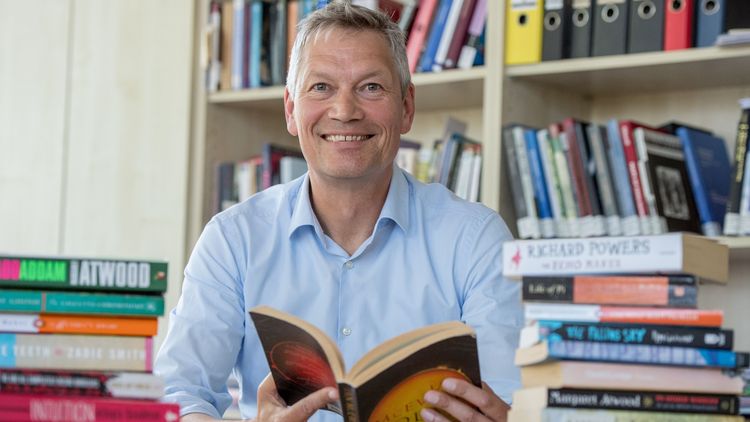Literary fiction can open up new perspectives on scientific research. The Anglicist Anton Kirchhofer examines how novels are overriding stereotypes and prejudices and thus elucidating the role of science in society.
Climate science, genetics, quantum mechanics – when Prof. Dr. Anton Kirchhofer, an expert in English literature, started engaging with these kinds of research fields some years ago it was like “leaping into cold water”. In the meantime, however, he has come to see his work on science-related novels as “highly rewarding”. The 55-yearold is one of the directors in the Fiction Meets Science programme. Together with literary and social science scholars from Oldenburg, Bremen and Hamburg, as well as international partners, Kirchhofer researches how novels address scientific topics and reflect the lives of scientists and their impacts on society – at a time when scientific knowledge is playing an ever-greater role in society. “The novels offer the public an entirely new perspective on the sciences,” he says. They show, for example, what a researcher’s everyday life in the lab looks like, or how gender might play a role in the way science gets done.
In a project funded by the Volkswagen Foundation the Fiction Meets Science scholars work together with novelists and scientists, discussing individual novels in workshops from their different disciplinary perspectives. For example, the unpublished manuscript of a science novel by British writer Pippa Goldschmidt, who recently spent nine months as writer-in-residence at the Hanse-Wissenschaftskolleg (Institute for Advanced Study) in Delmenhorst. “In this way we want to create a real dialogue between natural scientists, authors, literary scholars and social scientists,” explains Kirchhofer. It is precisely this interrelationship between academic research and practical work with the novels that makes this project so unique, Goldschmidt adds.
Rift between academic disciplines has not fully healed
This desire for a dialogue is by no means a given. In the 1990s, natural scientists, humanities scholars, and social scientists argued bitterly about the extent to which “hard” scientific knowledge is socially constructed. Though these “science wars” are considered a thing of the past, Kirchhofer says the rift between the academic disciplines has not fully healed. On the other hand, the science novels written since that time have refused to join the inter-disciplinary wars. Instead they have overcome the differences creatively, the literary scholar says. It is this creativity in the novels that the researchers want to tap into.
Since the start of the project in 2014, Kirchhofer and his colleagues have investigated dozens of contemporary Anglo-American science novels from various perspectives. They draw on a body of more than 250 books – and more are being added all the time. Kirchhofer’s analysis includes a study of the characters in the novels – for example how they are embedded in the structure of the novel, and the constellations within which they act. The literary scholars found few traces of mad scientists or Dr. No types hell-bent on world domination.
Literary characters are depicted as believably human
Instead, Kirchhofer explains, “what the novels all have in common is that they provide a realistic image that sets itself apart from the stereotypes.” The characters are often complex individuals, he says, with personal relationships and conflicts. For the literary scholar, this is a plus: “Readers are better able to identify with characters when they are depicted as believably human instead of just as clichés.” In particular, readers with a background in the sciences are able to identify with the books because they are written from perspectives which are familiar to them, he adds.
The researchers were also able to identify typical characters for specific scientific disciplines, such as genetics, neuroscience or climate science. Stories about geneticists, for example, often feature scientists who want to solve personal or social problems with genetic discoveries. “But it all goes wrong in the end,” Kirchhofer says. The takeaway message, he says, is worth taking note of: “We must solve social problems with social means and not expect genetics to come to the rescue.”
“Research and doubt are two sides of the same coin.“
Kirchhofer and his team have also studied how literary works are received by critics, including both classical literary critics and those who review novels for scientific journals such as “Nature”. It turns out that they all pose similar questions, such as whether or not the plot is plausible. “But,” the Anglicist explains, „the critics with a scientific background also want to know: Is our science portrayed accurately?” In addition they are sensitive to aspects of the novel that deal with the specifics of the scientific community, such as the degree to which investors are shown as determining the dominant research choices in particular disciplines, which theories are pitted against one another, or which results are inconsistent.
“These issues are highly pertinent for scientists,” Kirchhofer says. “But the public often knows nothing about them.” Unlike the communication that takes place within the scientific community ‒ in scientific journals, for example, or during coffee breaks at conferences ‒ where non-scientists are excluded, these novels provide a glimpse into “the black box”, the unknown world of science. And, he emphasises, this is where fictional stories can show something very important: “That science primarily produces questions and intermediate results rather than truths, and that research and doubt are two sides of the same coin.”

